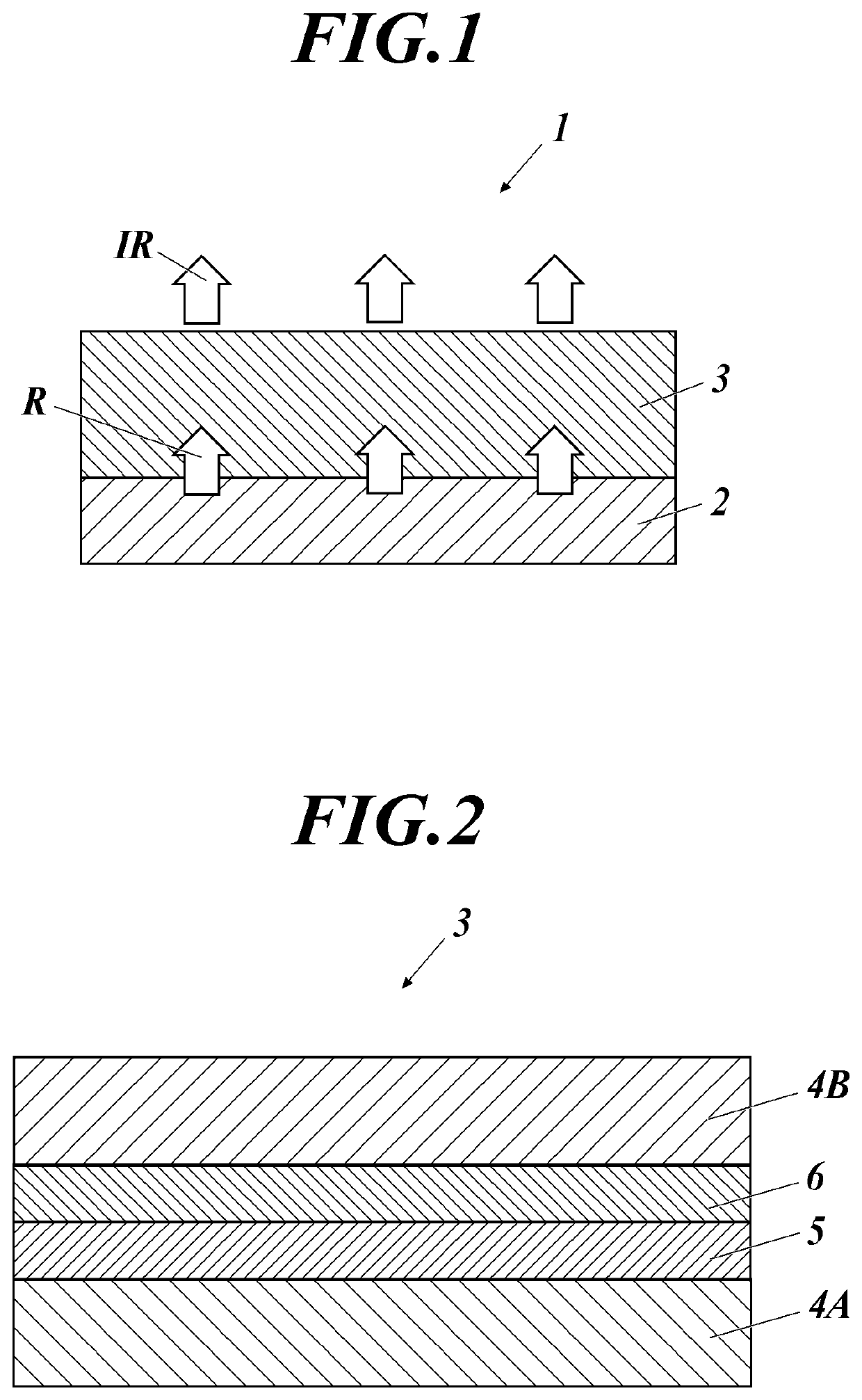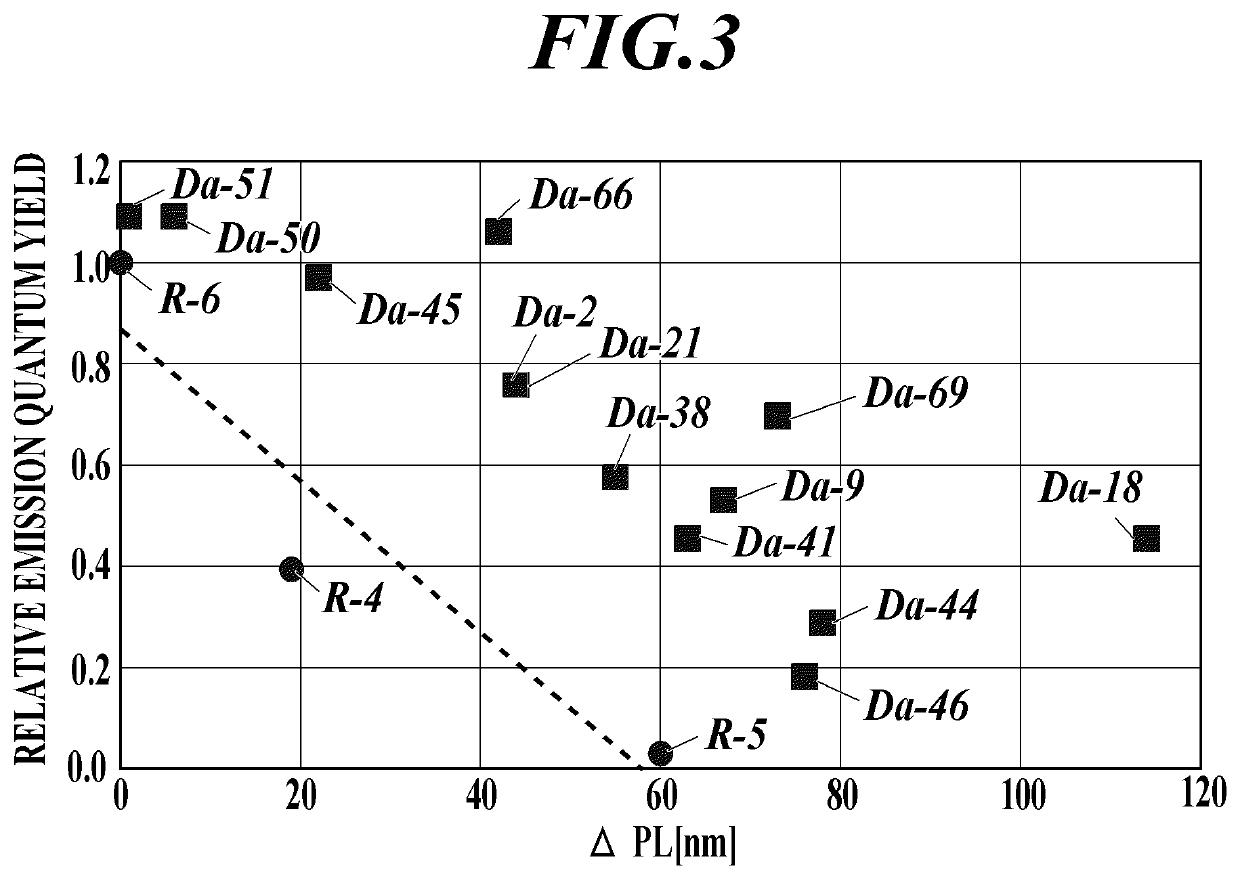Infrared-emitting compound, and luminescent thin film, luminescent particle, wavelength conversion film and infrared-emitting surface light source containing same
- Summary
- Abstract
- Description
- Claims
- Application Information
AI Technical Summary
Benefits of technology
Problems solved by technology
Method used
Image
Examples
example 1
[0104]For each of the 13 infrared-emitting compounds of the present invention and the comparative compounds R4 to R-6 used in the following examples, the dihedral angle was calculated using a Gaussian 09 manufactured by Gaussian, Inc. as a software for calculating a molecular orbital under the conditions described above The results are indicated in Table I. In the case of a compound having no substituent according to the present invention, it was described as a hyphen “-”.
TABLE IDihedral angleCompound[degree]RemarksR-4—Comparative ExampleR-538.4Comparative ExampleR-638.4Comparative ExampleDa-2186.4Present ExampleDa-3890Present ExampleDa-286.4Present ExampleDa-4190Present ExampleDa-4458.8Present ExampleDa-4558.8Present ExampleDa-4655.1Present ExampleDa-955.1Present ExampleDa-5090.0Present ExampleDa-5186.4Present ExampleDa-1886.4Present ExampleDa-6686.4Present ExampleDa-6958.8Present Example
[0105]The emission wavelength and the emission quantum yield in the solution of each of the 13 ...
example 2
[0119]The luminescence quantum yield in the luminescent particles was measured for the infrared-emitting compound of the present invention and the comparative compound.
(1) Preparation of Luminescent Particles
[0120]To 96 μL of a polystyrene (PS) particle dispersion (solid content: 5.2% by mass, volume average particle diameter of polystyrene particles: 0.12 μm, dispersion medium: water) were added 100 μL of water, 50 μL of a 2% aqueous solution of a nonionic surfactant (Kolliphor P407, manufactured by Sigma-Aldrich Co., Ltd.), and 100 μL of a 0.01 mmol / L THF solution of each compound shown in Table IV to prepare a mixed liquid of polystyrene particles and each compound. Polystyrene particles were prepared by stirring the mixture at 25° C. for 2 minutes.
[0121]Using a dispersion of the obtained polystyrene particles, the particles were sedimented by a centrifugal purification method, and after removing the supernatant liquid, pure water was added to redisperse the particles. This opera...
example 3
[Preparation of Wavelength Conversion Film]
(Preparation of Wavelength Conversion Film 3)
[0124]The wavelength conversion film 3 having the structure shown in FIG. 2 was produced according to the following method.
[0125]To toluene as a solvent, polystyrene (manufactured by ACROS ORGANICS Co., Ltd., weight-average molecular weight Mw=260000) as a matrix material and an infrared-emitting compound Da-53 of the present invention were added so as to have a mass ratio of 99:1, and these were placed in a eggplant flask and heated and stirred at 80° C. thereby sufficiently dissolving the mixture.
[0126]Next, on the entire surface of one side of a polyethylene naphthalate film (manufactured by Teijin DuPont Corporation, hereinafter abbreviated as PEN), the obtained mixed solution was applied using an applicator onto a gas barrier film in which an inorganic gas barrier layer made of SiOx was formed to have a thickness of 500 nm by using an atmospheric pressure plasma-discharge treatment apparatus...
PUM
 Login to View More
Login to View More Abstract
Description
Claims
Application Information
 Login to View More
Login to View More - R&D
- Intellectual Property
- Life Sciences
- Materials
- Tech Scout
- Unparalleled Data Quality
- Higher Quality Content
- 60% Fewer Hallucinations
Browse by: Latest US Patents, China's latest patents, Technical Efficacy Thesaurus, Application Domain, Technology Topic, Popular Technical Reports.
© 2025 PatSnap. All rights reserved.Legal|Privacy policy|Modern Slavery Act Transparency Statement|Sitemap|About US| Contact US: help@patsnap.com



